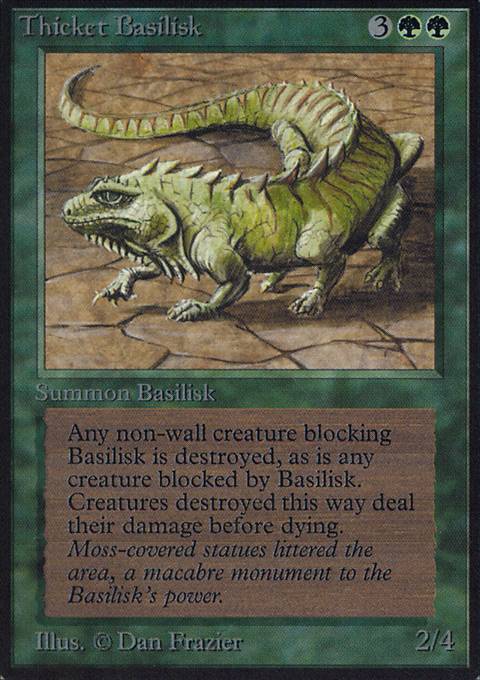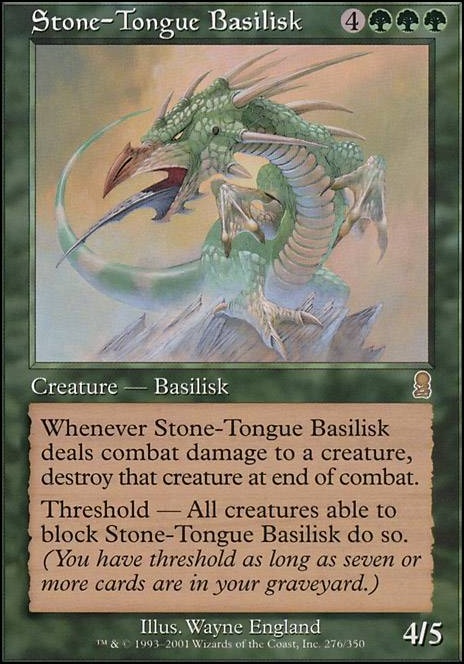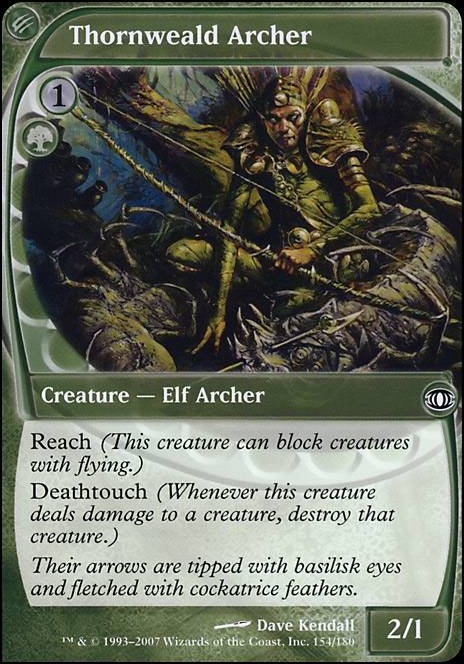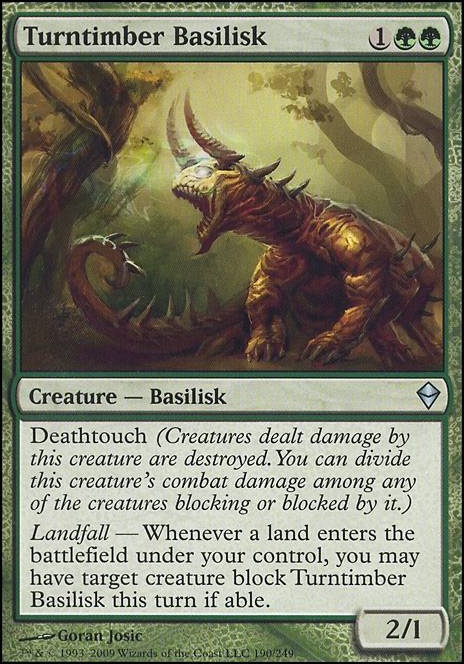Pattern Recognition #302 - Gaze into my Eyes
Features Opinion Pattern Recognition
berryjon
26 October 2023
289 views
26 October 2023
289 views
Hello Everyone! My name is berryjon, and I welcome you all to Pattern Recognition, TappedOut.Net's longest running article series. Also the only one. I am a well deserved Old Fogey having started the game back in 1996. My experience in both Magic and Gaming is quite extensive, and I use this series to try and bring some of that to you. I dabble in deck construction, mechanics design, Magic's story and characters, as well as more abstract concepts. Or whatever happens to catch my fancy that week. Please, feel free to talk about each week's subject in the comments section at the bottom of the page, from corrections to suggested improvements or your own anecdotes. I won't bite. :) Now, on with the show!
And with that out of the way, welcome back. Today's article concerns a subject I could have sworn I dealt with before, but it turns out its one of those things that I've only touched on tangentially to another subject. Today, I'm going to talk about one of the early powerhouses of the game, one whose integral mechanic would finally be refined and codified in the Time Spiral Block. So today, let's talk the Basilisk creature type.
Starting with this glorious fellow right here:
The Thicket Basilisk was one of my mainstays back in the day, and I still have fond memories of it. The Thicket Basilisk was an interesting creature in that if it blocked or was blocked, it would destroy all creatures that blocked or was blocked by it. I'm a little proud to say that when I designed my Duelist mechanic for Solle, the wording on this creature held a certain degree of inspiration.
The Basilisk was an absolute beast when paired with Lure from the same set, as this was how would clear the board of creatures in order to win the game. If everything went after the Basilisk, then everything would die and you would be laughing all the way to victory. Yes, you would lose the creature and the Lure, but that was a small price to pay for Victory.
However, the Basilisk had a small problem, one that was a legacy of ancient game design. Namely that the game was still awkwardly growing up, and the Vorthos of the cards was still in play. And so, how does a Basilisk, something which famously kills either by its gaze or by its breath, kill a wall, which neither breathes nor sees (please ignore Living Wall)? I can't really defend this, and neither could Wizards, as while this creature made it to 6th Edition, it was soon set aside in favor of other cards.
The Thicket Basilisk was also a rules annoyance as it created a Delayed Trigger, thanks to how it works. The Trigger for the ability is put onto the relevant creatures when blockers are declared, but they don't go into effect until the end of combat. It is something that Wizards doesn't like to do now, but still can as long as cause-and-effect are clearly denoted in the player's mind. And in this case, it's pretty obvious. Block or be blocked? Die!
The Sylvan Basilisk deserves some respect here as a card that made it out of Portal Second Age, into Starter 1999, and then into the fill game with Tenth Edition. However, it, and Lowland Basilisk both represent different ways to address the above issue. The Sylvan version of this card focuses on the combat step, and skips the delayed trigger part of the combat. The act of blocking destroyed the creature - but still leaves the Basilisk blocked, meaning that unless it has Trample or Super-Trample, its damage is blocked as well. The Lowland Basilisk tried to fix the timing issues (and re-balance the cost/power/toughness ratios) by stating that simply dealing damage was enough to kill the opposing creature - meaning that in this case, a creature with 3 or more power and First Strike could survive the Basilisk.
Also, I asked myself after reading the Lowland version - what happens if this creature deals damage outside of combat? Arena did exist at this time, but this was long before Bite and Fight cards, so what gives?
Turns out, according to the card's rulings, part of a global update in 2004, +If it damages a creature outside of combat, its effect will destroy the creature at the end of the next combat." So yeah, if this guy Bites your creature before combat, that creature won't die from the trigger until the end of combat on that turn. And if I enchant it with Fire Whip, then ping a creature in my second main phase, that creature won't die until the end of the next combat - on the next turn!
Magic gets weird folks.
Anyway, bask to the Basilisks.
The next one is the Rock Basilisk, and this one was just a normal Basilik, except with the addition of to the mana cost and inflated stats. There's nothing unusual to see here.
But then there's this guy....
You know how I said Lure and Thicket Basilisk was amazing? Well, what if you literally stapled both of them together, and increased the creature's power and toughness to be within seeing distance of reasonable for a creature with a mana value of ? I can't say that it was a case of good card design, and I really should take another look at those cards, which were effectively two stapled together.
However, this creature also had the drawback of the Lure effect being tied to the Threshold mechanic, which is to say that it won't turn on until you have 7 or more cards in your graveyard. Which is another article for the future, but for now, this creature was intended to be a later game bomb. When your graveyard was full, you can drop this, and know that you can push the rest of your team through with one card, going for the win.
Your actual mileage may vary, of course.
The Simic Basilisk was horribly over-costed, but at the same time, you could grant the Basilisk ability to any creature with a +1/+1 counter on it, something that played well with the Graft mechanic for the Simic in Dissension. And even now given just how much of is tied up in +1/+1 counters. Heck, we're getting Explore back with the next set, which means that with this guy, you can throw down overly complicated kill triggers onto your entire board!
Yeah, didn't think so either.
But it was the last straw for the ability, and Wizards went back to look at the whole things and try to determine what went right and what went wrong with it. The notion of a combat auto-kill was something that worked from a design and concept standpoint. That Wizards had the Basilisk ability in their back pockets this whole time, and kept using it, and it kept being played showed that the playerbase was alright with this sort of thing. That as long as you were willing to lose it in the process, having a creature that could, for one glorious moment, punch way out of its weight class was appealing.
And so, with a shock that didn't quite match Damnation, Future sight brought us this:
This creature codified both Reach and Deathtouch - as this was the first use of both Keywords, but wasn't a Basilisk, so it gets a nod, but I have to leave it behind.
Deathtouch became the replacement for the Basilisk ability, and best of all, it could apply to anything which was poison... tox... could harm things without needing to do much damage to them. Of course, it would take until Zendikar for these two to come back together where they belong.
From Zendikar, this Deathtoucher included a single target Lure effect that came from a Landfall trigger. This creature I liked because it was again, a Lure effect, and it didn't have the same global removal that previous versions did. And because it was a Landfall trigger, combined with 2 Power, meant that you could double-Landfall in a turn (It's , not that hard), and Lure two separate creatures to their death.
From there, Basilisks show up occasionally as the Cheap Or Common Deathtouch Creature for a set when they don't give it to a Snake or to an Elf. Greater Basilisk, Daggerback Basilisk and Underdark Basilisk, with the most recent offering being Ichorspit Basilisk. Who also had Toxic, which was just needless and cruel.
Basilisks exist in an awkward spot of being lizard-like, but not actually having the creature type of Lizard, and their tribal/typal mechanic is something that can't be used too often due to its outsized effects on combat in the game. But as I have shown, the creature is still in Wizards' toolbox, and can be pulled out on occasion, even if it's just to mix things up and not have the same old Moss Viper or Sedge Scorpion or Fang of Shigeki.
And while Basilisks had their day in the sun, no matter how little it really was, their effect on the game as the source for Deathtouch cannot be denied. In addtion, because of the move to Keywording the successor ability, Wizards could then better anchor it to other effects, which in the end, resulted in Mirror Shiedl as the anti-Deathtouch card, and Fynn, the Fangbearer to drive the Deathtouch to the player with Poison counters (ugh).
I liked Basilisks, but I can understand why their historic ability has been depreciated. It was needlessly complicated, and didn't do much for the game at the time. Evolving it was the best choice, and as an evergreen mechanic, it is a living reminder that bigger is not always necessarily better. Sometimes, a 1/1 in the right place at the right time can make all the different in the world.
As long as it can kill you dead with just a touch.
Thank you all for sticking with me this week! Join me next week when I talk about something different. What it is, I don't know yet.
Until then, please consider donating to my Pattern Recognition Patreon. Yeah, I have a job (now), but more income is always better, and I can use it to buy cards! I still have plans to do a audio Pattern Recognition at some point, or perhaps a Twitch stream. And you can bribe your way to the front of the line to have your questions, comments and observations answered!



